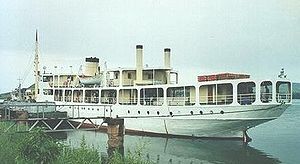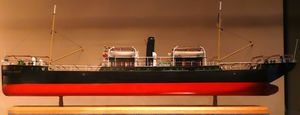MV Liemba

| |
| Career | |
|---|---|
| Name: |
Graf von Götzen (1913-1916) Liemba (1927-present) |
| Port of registry: |
22x20px Kaiserliche Marine (1913-1916) |
| Builder: | Jos. L. Meyer, Papenburg, Germany |
| Laid down: | 1913 |
| Launched: | 1914 |
| Homeport: | Kigoma, Tanzania |
| Status: | in active service, as of 2026[update] |
| General characteristics | |
| Displacement: | 1,575 t |
| Length: | 232 feet (70.71 m) |
| Beam: | 33 feet 10 inches (10.31 m) |
| Propulsion: | Steam engine (until 1970, replaced with Diesel): triple expansion, 500 ihp (370 kW), 2 screws |
| Speed: | 9 knots (17 km/h) |
| Complement: |
18 1st class 16 2nd class 350 3rd class |
| Armament: | 10.5 cm gun and two 3.7 cm revolver guns from SMS Königsberg (removed 1916) |
The MV Liemba, formerly the Graf von Götzen, is a passenger cargo ferry that runs along the eastern shore of Lake Tanganyika. The ship was built in 1913 in Germany, and was one of three vessels operated by the Germans to control Lake Tanganyika during the early part of World War I. It was scuttled by its captain on 26 July 1916 off the mouth of the Malagarasi river, during the German retreat from the town of Kigoma. In 1924 the ship was salvaged by a British Royal Navy salvage team and recommissioned in 1927 as the Liemba. The vessel is now owned by the Tanzania Railways Corporation and runs between the ports of Bujumbura, Burundi, Kigoma, Tanzania and Mpulungu, Zambia with numerous stops to pick up and set down passengers in between.
The ship was the inspiration for the German gunboat Luisa in C.S. Forester's 1935 novel The African Queen, and the subsequent film version. The story of the ship's sinking was recently retold in a book by Giles Foden entitled Mimi and Toutou Go Forth. The Bizarre Battle for Lake Tanganyika. In 1992 the boat featured in the travel series Pole to Pole and Michael Palin stayed in one of the ship's cabins.
Contents
History
Early history
The Graf von Götzen was built in 1913 at the Meyer-Werft Shipyard in Papenburg, Germany, and named after Count Gustav Adolf Graf von Götzen, the former governor of German East Africa. After a preliminary assembly, the ship was taken apart and shipped in parts to East Africa to serve as a passenger and cargo ferry, in addition to the Tanganyika railroad. It arrived first in Dar es Salaam, and was then taken on the Central Line to Kigoma, on Lake Tanganyika. It was there, in 1914, that the ship was rebuilt and launched, in June 1915.
World War I
With the aid of the Götzen which had been additionally equipped with a 10.5 cm (4.1 in) gun from the SMS Königsberg, the Germans had complete supremacy of the lake in the early stages of the war. The ship was used both to ferry cargo and personnel across the lake, and as a base from which to launch surprise attacks on Allied troops. It therefore became essential for the Allied forces to gain control of the lake themselves. Under the command of Geoffrey Spicer-Simson and the Royal Navy they achieved the monumental task of bringing two armed motor boats Mimi and Toutou from England to the lake by rail, road and river to Kalemie on the western shore of Lake Tanganyika. The two boats waited until December 1915, and mounted a surprise attack on the Germans, with the capture of the gunboat Kingani-renamed HMS Fifi. Another German vessel, the Hedwig von Wissman, was sunk in February 1916, leaving the Götzen as the only German vessel remaining on the lake.

As a result of their strengthened position on the lake, the Allies advanced towards Kigoma by land, and the Belgians established an airbase on the western shore at Albertville. It was from there, in June 1916, that they launched a bombing raid on German positions in and around Kigoma. It is unclear whether or not the Götzen was hit (the Belgians claimed to have hit it but the Germans denied this), but German morale suffered and the ship was subsequently stripped of its gun since it was needed elsewhere.
The war on the lake had reached a stalemate by this stage, with both sides refusing to mount attacks. However, the war on land was progressing, largely to the advantage of the Allies, who cut off the railway link in July 1916 and threatened to isolate Kigoma completely. This led the German commander, Gustav Zimmer, to abandon the town and head south. In order to avoid his prize ship falling into Allied hands, Zimmer ordered that the vessel be scuttled. The task was given to the three engineers from Meyer Werft who had traveled with the dismantled ship to Lake Tanganyika in order to supervise its assembly. They decided on their own that they would try to enable a later salvage; they loaded the ship with sand and covered all engines with a thick layer of grease before sinking her carefully on July 26, off the mouth of the Malagarasi River.
Resurrection
The Götzen remained on the bottom of Lake Tanganyika until 1924, when it was salvaged by the British, to aid transport around the lake in the new protectorate of Tanganyika. They found that the engines and boilers were still usable and the ship returned to service in May 1927 as a passenger and cargo ferry under the new title MV Liemba. [1]
Recent history
The ferry has been operating almost nonstop since that date. After Tanzanian independence in 1961, the Tanzania Railways Corporation took over the running of the ferry, allowing them to tie in services with the Central Line from Kigoma to Dar es Salaam. In 1970, the ship underwent an overhaul, in which the original steam engines were replaced with twin diesels and the accommodation upgraded, allowing an increase in passenger numbers from 430 to 600.
In 1993 the vessel underwent a further overhaul managed by a Danish shipyard, Karstensen Shipyard, Northern Jutland, sponsored by Danida, a Danish developmental organization.
In 1997, the Liemba was used by the UNHCR, along with the MV Mwongozo, to transport more than 75,000 refugees, who had fled Zaire during the First Congo War, back to their homeland following the overthrow of longtime dictator Mobutu Sese Seko. The ship made a total of 22 trips between Kigoma and Uvira during this five month operation.
The African Queen
The original version of The African Queen written by C.S. Forester and serialised in the News Chronicle in 1934 was very different from the one we associate with the film. In this Rose and Allnut are planning to attack a German cruiser named Dortmund (loosely based on the SMS Königsberg), with the launch sailing down the river to attack it in the river delta.
In the book the The German gunboat Königin Luisa (referred to by hero Charlie Allnutt as the Louisa), is based on the Kingani, a German gunboat sunk on Lake Tanganyika and to a certain extent the events portrayed in the film are based on the dramatic military operation carried out by the Royal Navy, but the events described in the book bear little resemblance to the true historical events.[2] The book was subsequently made into a film, the 1951 classic The African Queen, starring Humphrey Bogart and Katharine Hepburn. The gunboat used in the filming, was played by the steam-tug Buganda on Lake Victoria, which was used for the long shots. The film brought a certain notoriety to the Götzen/Liemba, however. Like its real life counterpart, the Luisa ended up at the bottom of Lake Tanganyika, following a collision with the 'hero boat' African Queen towards the end of the film.
Ferry operation
The Liemba runs a weekly service in each direction, running from Kigoma to Mpulungu Wednesday to Friday, and back again from Friday to Sunday. Accommodation ranges from 1st class (luxury cabin) to 3rd class (seating only).
There are docks at Kigoma, Mpulungu and Kasanga, but at all other stops, passengers must travel to the shore by way of a smaller boat. Notable stops along the route include: Lagosa (for Mahale Mountains National Park), Karema (for Mpanda) and Kipili or Kasanga (for Sumbawanga).
Notes and references
- ↑ Liemba was a regional name for the southern part of the lake, a word probably from the Fipa language. The Last Journals of David Livingstone in Central Africa from 1865 ..., Volume 1 p. 338; via google books
- ↑ Foden, Giles (2005). Mimi and Toutou Go Forth: The Bizarre Battle of Lake Tanganyika (p266) Penguin Books Ltd. ISBN 0-14-100984-5
Bibliography and external links
- Fitzpatrick, Mary, et al. (2001). Lonely Planet: East Africa (6th ed.). Victoria: Lonely Planet Publications Pty Ltd. ISBN 1-74059-131-3
- Shipwrecks & Salvage on the East African Coast by Kevin Patience - 2006
- Pages with broken file links
- Articles containing potentially dated statements from 2026
- Articles with invalid date parameter in template
- All articles containing potentially dated statements
- Ferries of Tanzania
- Ferries of Zambia
- German East Africa
- Lake Tanganyika
- Passenger ships of Tanzania
- Ships built in Papenburg
- Ships of the German Imperial Navy
- 1913 ships
